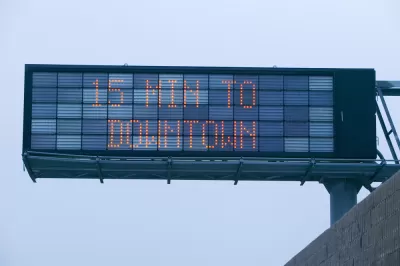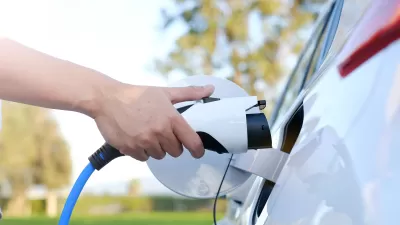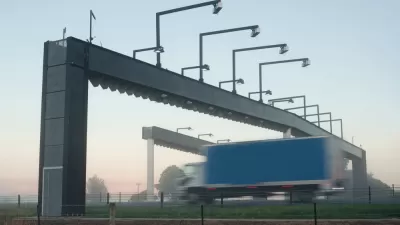Some argue that even if wider roads induce more travel, they will actually reduce pollution by speeding it up. This post addresses one such argument.

I was recently reading the Reason Foundation's pro-road newsletter and came across a critique of induced demand: the idea that because wider roads increase demand for automobile travel, they actually increase, rather than reduce, congestion.
The author, Baruch Feigenbaum, makes three interesting arguments.* His most interesting argument is that new roadway capacity "can reduce greenhouse gas emissions if it allows free-flowing traffic to replace stop-and-go traffic." In other words, we can increase vehicle miles traveled and yet reduce emissions by reducing congestion.**
But if this was an important factor over the long run, places with low levels of congestion would consistently have lower greenhouse gas emissions than less automobile-dependent places with high levels of congestion. Let's look at the data: according to the 2021 report of the Texas Transportation Institute TTI)*** the five most congested very large urban areas (based on 2019 data for delay per auto commuter) are Los Angeles, Washington, San Francisco, New York, and Boston; all of these metros have denser-than-average central cities, and most of them have higher-than-average levels of public transit use.
According to a paper by economists Edward Glaeser and Matthew Kahn, the driving-related emissions from these five dense metros range from 18,081 pounds of carbon per household/year (New York) to 25,918 (Washington); drivers in three of the five cities produced between 22,000 and 24,000 pounds of carbon per household/year.
The five least congested very large metros were Detroit, Dallas, Phoenix, Philadelphia and San Diego—four car-dependent metros and one outlier (Philadelphia). Detroit and Dallas produced over 27,000 pounds of car-related carbon per household/year, more than any of the five most congested metros. Phoenix produced just over 25,000 pounds, more than four of the five most congested metros. San Diego produced 24,774 pounds, also more of the four of the five most congested metros. Of the least congested large metros, only Philadelphia had emissions comparable to those of Boston or San Francisco—perhaps because unlike the other four, Philadelphia has a dense central city with relatively high transit ridership.
On balance, the most congested metros seem to have lower automobile-related carbon emissions than the least congested ones, and the only large metro with both low congestion and low emissions is one with relatively high transit use. To put the matter more bluntly: metros with dense cores have lower emissions, even if they have high congestion. It logically follows that high density and high transit use are far more environmentally beneficial than low congestion.
Feigenbaum also argues that new roads have economic benefits, by allowing "employees to reach a larger number of employers in a given time" and "increasing the number of consumers that can reach businesses in 15 minutes." I am prepared to assume that this is true in the very short run, notwithstanding any congestion caused by induced demand.
But over the longer run, new and wider roads, by opening up exurbs for development, shift businesses further away from consumers and employees. In the pre-suburban Atlanta of 1940, an employee would never have to travel more than a few miles for a job; today, much longer commutes are common, because the interstate system has spread jobs and housing dozens of miles into suburbia. So what the commuter gains in speed she loses in distance.
If road-heavy sprawl actually created the promised benefits, U.S. commuting times would have consistently gone down over time, because the benefits of increased speed would have outweighed the costs of increased distance. Instead, commuting times have consistently increased. These increases aren't just limited to environmentally-minded states like California and Oregon, where one might expect road construction to have slowed down. In Texas, for example, the average commute time increased from 22 minutes in 1990 to 25 minutes in 2013. And even if commuting times had been exactly the same, a commuter would arguably be worse off under road-generated sprawl than under the status quo ante, because the increased distance of her commute would deprive her of non-automotive options.****
Feigenbaum also argues that new roadway capacity makes roads safer, as "roadways are widened from narrow, curvy two-lane roads to four-lane divided highways, partly for better mobility but also for increased safety." There is an element of truth in this argument: a country road with no pedestrians is safer as a four-lane road than a two-lane road, and so is a limited-access highway. On the other hand, no sane person would feel safer if their residential street was widened from two lanes to four, or if their downtown main street was widened so that cars could go fast enough to kill pedestrians with ease. But the flood of road money flowing into state highway departments allows the latter as well as the former.
*Much of his post is devoted to technical arguments, which I will leave to people more expert than myself in such matters.
**A related argument is that faster travel reduces fuel consumption. But this is not quite the same thing: a car going 50 mph on a high-speed arterial is subject to far more stop-and-go traffic than the same car going 50 mph on a limited-access highway.
***I note that smart growth advocates have criticized TTI; however, I am not sure there is a better measure of regional congestion available yet.
****Of course, there are a wide variety of costs and benefits to suburban sprawl that are less directly related to transportation. For example, one positive side effect might be larger houses; negative side effects include (among other things) greenhouse gas emissions caused by those larger houses, decay in urban and inner suburban areas caused by middle-class flight to suburbia, and rising car crash deaths.

Alabama: Trump Terminates Settlements for Black Communities Harmed By Raw Sewage
Trump deemed the landmark civil rights agreement “illegal DEI and environmental justice policy.”

Planetizen Federal Action Tracker
A weekly monitor of how Trump’s orders and actions are impacting planners and planning in America.

The 120 Year Old Tiny Home Villages That Sheltered San Francisco’s Earthquake Refugees
More than a century ago, San Francisco mobilized to house thousands of residents displaced by the 1906 earthquake. Could their strategy offer a model for the present?

Housing Vouchers as a Key Piece of Houston’s Housing Strategy
The Houston Housing Authority supports 19,000 households through the housing voucher program.

Rural Population Grew Again in 2024
Americans continued to move to smaller towns and cities, resulting in a fourth straight year of growth in rural areas.

Safe Streets Grants: What to Know
This year’s round of Safe Streets for All grant criteria come with some changes.
Urban Design for Planners 1: Software Tools
This six-course series explores essential urban design concepts using open source software and equips planners with the tools they need to participate fully in the urban design process.
Planning for Universal Design
Learn the tools for implementing Universal Design in planning regulations.
Clanton & Associates, Inc.
Jessamine County Fiscal Court
Institute for Housing and Urban Development Studies (IHS)
City of Grandview
Harvard GSD Executive Education
Toledo-Lucas County Plan Commissions
Salt Lake City
NYU Wagner Graduate School of Public Service






























